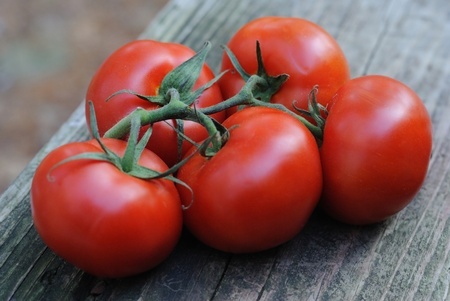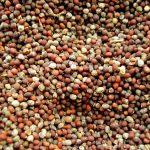
♦ Tomato seeds contain useful proteins which could be useful in other foods but just get thrown away
The ubiquitous tomato (Lycopersicon esculentum L) is grown globally for its versatility as a raw fruit, as a processed product and its widespread multiple applications in cooking. Along with the onion, it may be the most popular foodstuff around. It not only has a high nutritive value, it is recommended for consumption by the medical profession dealing with serious heart conditions.

Most tomatoes are processed into juices, ketchup, sauce, paste, puree and powder. The solid waste that remains after the juicing and pulp extraction is mainly seeds, skin, pieces of fibre, trimmings, cores and cull tomato. This waste is up to now been dumped, flushed into sewage, streams and rivers or to some extent used as fertilizers.
There is a valuable resource however in not only skins but the seeds. Tomato seed protein has been found to have a high lysine content which could be used to substantially improve the amino-acid/protein quality of many different food products low in this amino acid. Cereals, baked goods, desserts, nutrition supplements and other products, are all possibilities (Brodowski & Geisman, 1980).
A large body of research was conducted in the late 70s and 80s into developing breads containing tomato seed meal (Carlson et al., 1981; Knorr & Betschart, 1978; Sogi et al., 2002; Yaseen et al., 1991). The functional benefits as well as nutritional ones have been cited extensively.
Bread to which tomato seed meal has been added produces some notable functional improvements such as better loaf volume, texture and crumb quality, due to its anti-staling properties (Morrison, 1976).
The tomato seed proteins have been compared to other important and commercially available protein sources such as casein and whey proteins generally. It is ‘felt’ that casein has a better amino-acid profile from a nutrition point of view but the evidence remains to be gathered and the value of such a readily available material should not be ruled out. It was reported that in vitro digestibility employing pepsin and pancreatin, was 61.8% for tomato seed meal as compared to 80% for casein.
One area of interest too is the value of the seed oil as a replacement for diesel (Giannelos et al., 2005).
References
Brodowski, D., & Geisman, J. R. (1980). Protein content and amino acid composition of protein of seeds from tomatoes at various stages of ripeness. J. Food Sci., 45, pp. 228–229, 235.
Carlson, B. L., Knorr, D., & Watkins, T. R. (1981). Influence of tomato seed addition on the quality of the wheat flour breads. J. Food Sci., 46, pp. 1029–1031, 1042.
Giannelos, P. N., Sxizas, S., Lois, E., Zannikos, F., & Anastopoulos, G. (2005). Physical, chemical and fuel related properties of tomato seed oil for evaluating its direct use in diesel engines. Industrial crops and products, 22(3), pp. 193-199.
Knorr, D., & Betschart, A. A. (1978). The relative effect of an inert substance and protein concentrates upon loaf volume of breads. Lebensmittel-Wissenschaft und Technologie, 11, pp. 198–200.
Morrison, W. R. (1976). Lipids in flour, dough and bread. Bakers Digest, 50, pp. 29–31.
Rahma, E. H., Moharram, Y. G., & Mostafa, M. M. (1986). Chemical characterization of tomato seed proteins (Var Pritchard). Egyptian J. Food Sci., 14, pp. 221–230.
Sogi, D. S., Bhatia, R., Garg, S. K., & Bawa, A. S. (2005). Biological evaluation of tomato waste seed meals and protein concentrate. Food Chem., 89(1), pp. 53-56
Sogi, D. S., Sidhu, J. S., Arora, M. S., Garg, S. K., & Bawa, A. S. (2002). Effect of tomato seed meal supplementation on dough and bread characteristics of wheat (PBW-343) flour. Int. J. Food Properties, 5, pp. 563–571
Yaseen, A. A. E., El-Din, M. H. A., & El-Latif, A. R. A. (1991). Fortification of Balady bread with tomato seed meal. Cereal Chemistry, 68, pp. 159–161


Leave a Reply